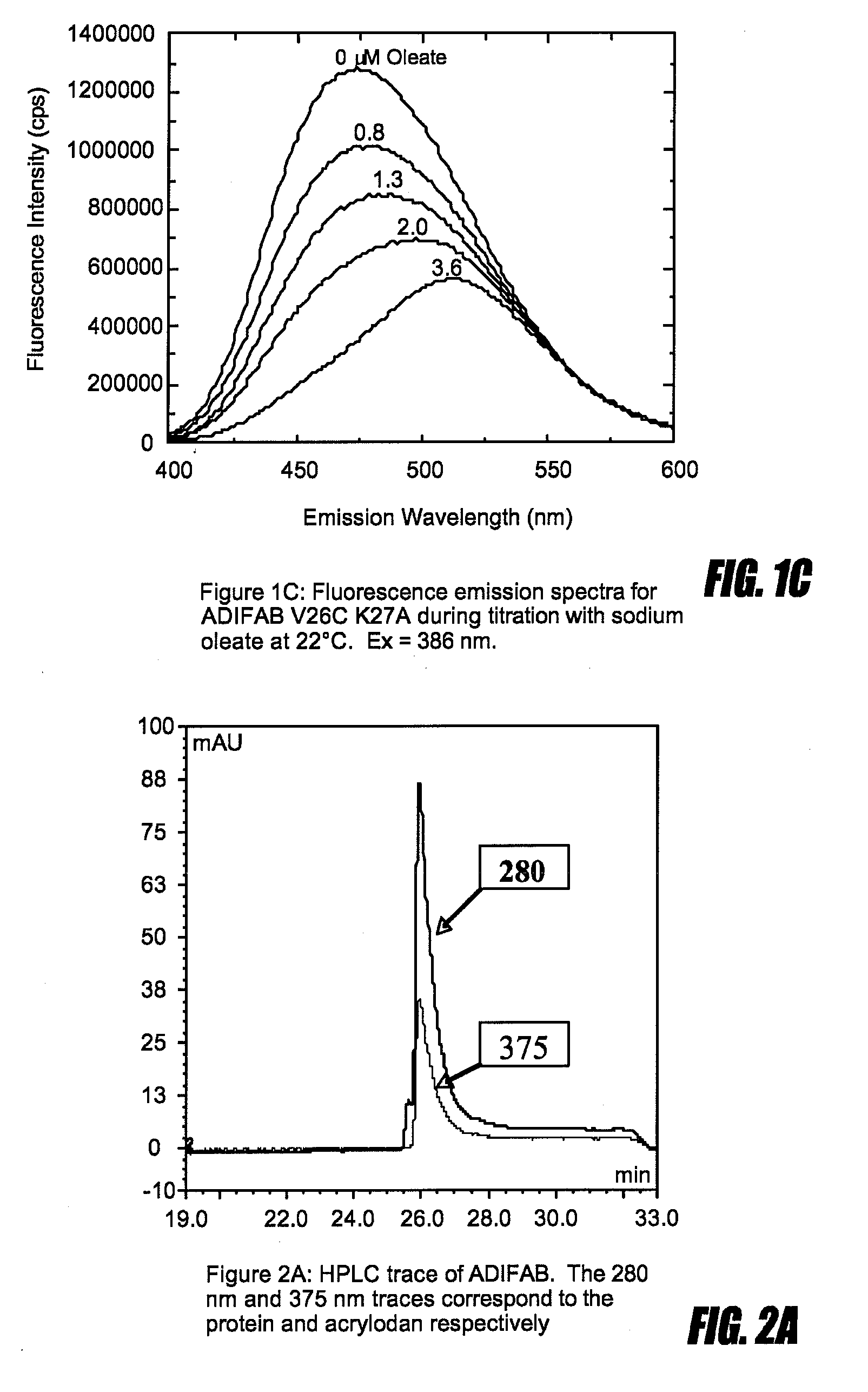Development and use of cysteine-labeled fluorescent probes of unbound analytes
a fluorescent probe and cysteine-labeled technology, which is applied in the field of development and use of cysteine-labeled fluorescent probes of unbound analytes, can solve the problems of insufficient molecular theory to design probes with any desired specificity and sensitivity de novo, inability to improve specificity and signaling through a completely random mutational strategy, and requires extensive time. , to achieve the effect of reducing the intensity and/or wavelength of emitted flu
- Summary
- Abstract
- Description
- Claims
- Application Information
AI Technical Summary
Benefits of technology
Problems solved by technology
Method used
Image
Examples
example 1
[0107]ADIFAB, which is the rat intestinal FABP (SEQ ID NO:2) labeled with acrylodan at lysine 27 reveals a red shift in its fluorescence emission spectrum upon binding FFA (FIG. 1a). This response which reveals an isoemissive point can be used to relate the ratio of the fluorescence intensities at two wavelengths, for example 505 nm and 432 nm, to the concentration of the unbound FFA (Richieri et al J. Biol. Chem. (1992) 267:23495-23501). This is an example of the type of fluorescence response that is a necessary characteristic of a probe. In contrast, mutating lysine 27 of SEQ ID NO:2 to cysteine and labeling the cysteine with acrylodan results in a fluorescent protein that, although it is responsive to FFA binding by revealing a quenching of fluorescence, does not reveal a change in emission wavelength upon FFA binding and can therefore not be considered a probe (FIG. 1B). However, if instead of mutating lysine 27 to cysteine, lysine 27 is mutated to alanine and, valine at positio...
example 2
[0110]Several lysine labeled probes, revealing high sensitivity and specificity for particular FFAu, but exhibiting unfavorable labeling profiles because of a lack of labeling homogeneity and / or poor labeling stoichiometry were converted to cysteine labeled probes. This was done by substituting cysteine for the wild type side chains at several sites from the group M21, I23, N24, V25, V26, K27, R28, K29, L30, G31, F55, D74, A73 or T76 depending upon the probe mutations. The HPLC traces shown in FIG. 3 illustrates the labeling improvement for such 3 examples (Huber et al Biochemistry (2006) 45:14263-14274). Each of these cysteine substitutions resulted in responsive probes with very similar FFAu profiles as the lysine probes (FIG. 4).
example 3
[0111]More than 40 libraries of cysteine-labeled mutant probes, using templates derived from SEQ ID NO: 5, with the number of different mutant probes in the various libraries ranging from 2000 to 2,000,000 have been generated using the methods described in U.S. application Ser. No. 11 / 085,792, incorporated herein by reference. In these libraries the single cysteine residue was introduced at one of the sites from the group M21, I23, N24, V25, V26, K27, R28, K29, L30, G31, F55, D74, A73 or T76. Mutant probes from these libraries reveal high degrees of sensitivity and specificity for different FFAu and reveal high degrees of labeling homogeneity and labeling stoichiometry. Two sets of examples from two such libraries are shown in FIG. 5 to illustrate the diversity of possible probes. In this example of screening for mutant probes FFA were added as complexes with albumin to clamp the levels of FFAu.
PUM
| Property | Measurement | Unit |
|---|---|---|
| Concentration | aaaaa | aaaaa |
| Acidity | aaaaa | aaaaa |
| Surface | aaaaa | aaaaa |
Abstract
Description
Claims
Application Information
 Login to View More
Login to View More - R&D
- Intellectual Property
- Life Sciences
- Materials
- Tech Scout
- Unparalleled Data Quality
- Higher Quality Content
- 60% Fewer Hallucinations
Browse by: Latest US Patents, China's latest patents, Technical Efficacy Thesaurus, Application Domain, Technology Topic, Popular Technical Reports.
© 2025 PatSnap. All rights reserved.Legal|Privacy policy|Modern Slavery Act Transparency Statement|Sitemap|About US| Contact US: help@patsnap.com



